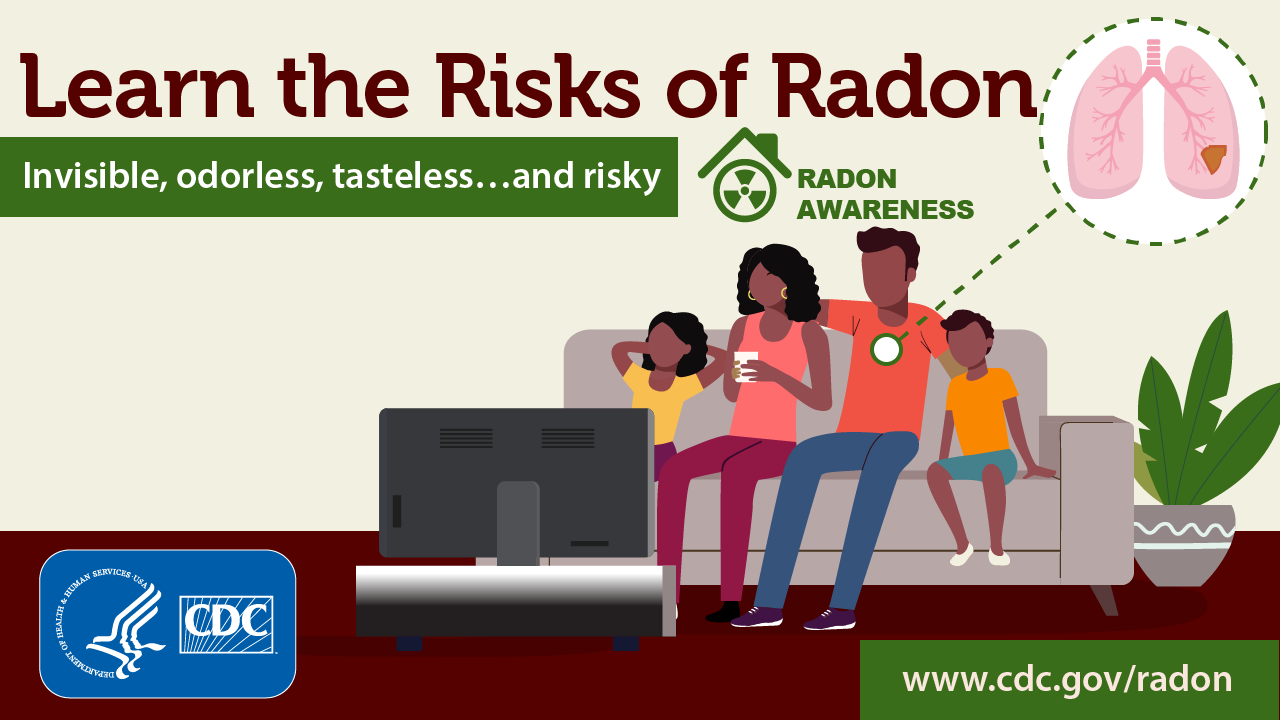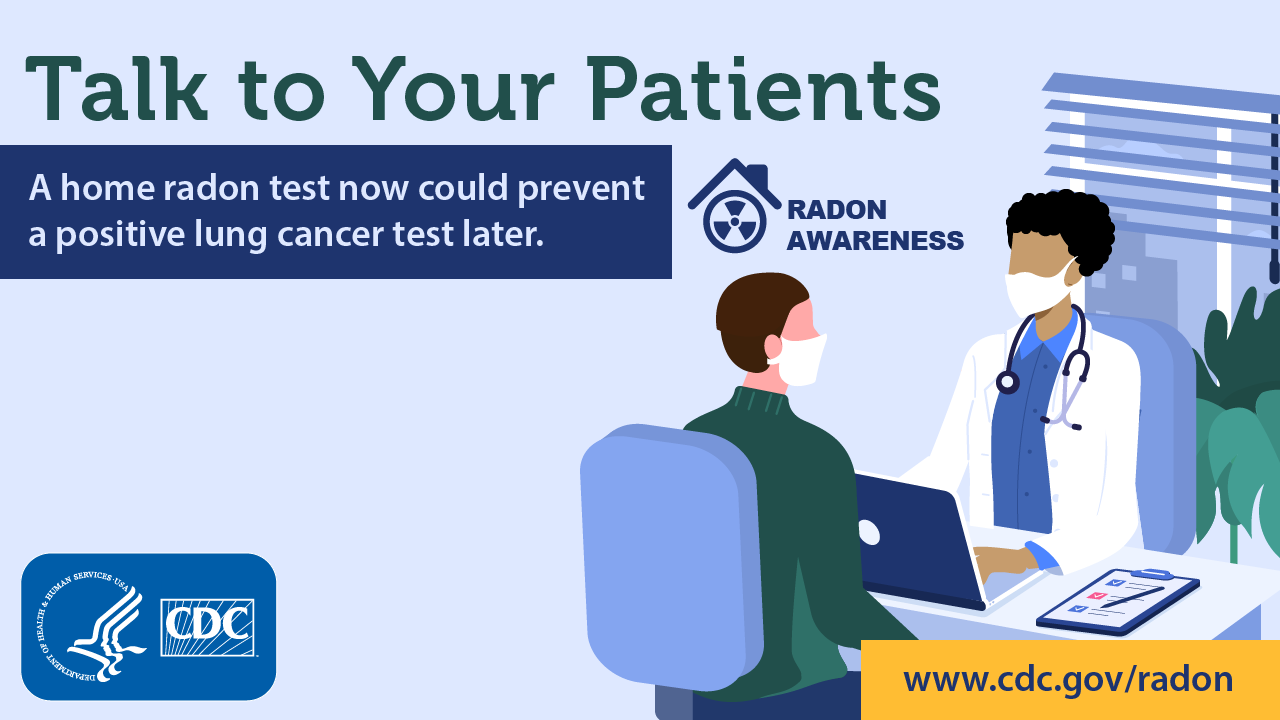Radiation and Health Newsletter – January 2022
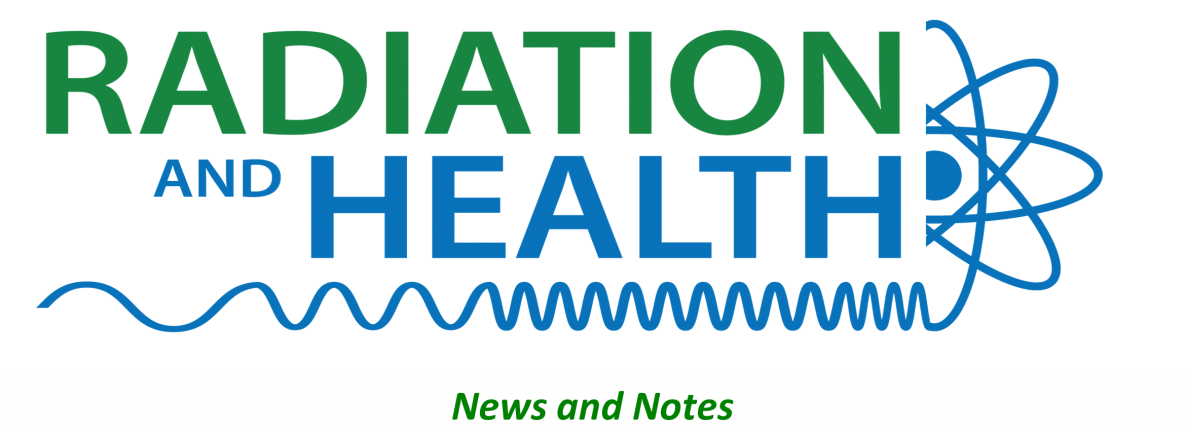
January is National Radon Action Month!
If you’ve ever sold a house or bought a house, you may have heard about radon—but how much do you know about this silent danger?
Well, if you’re like most people, probably not much—but you should! January is National Radon Action Month, led by the Environmental Protection Agency and partners, and CDC is sponsoring its second annual Radon Awareness Week January 24–28, 2022. Learn about radon risks and what you can do to reduce or prevent them.
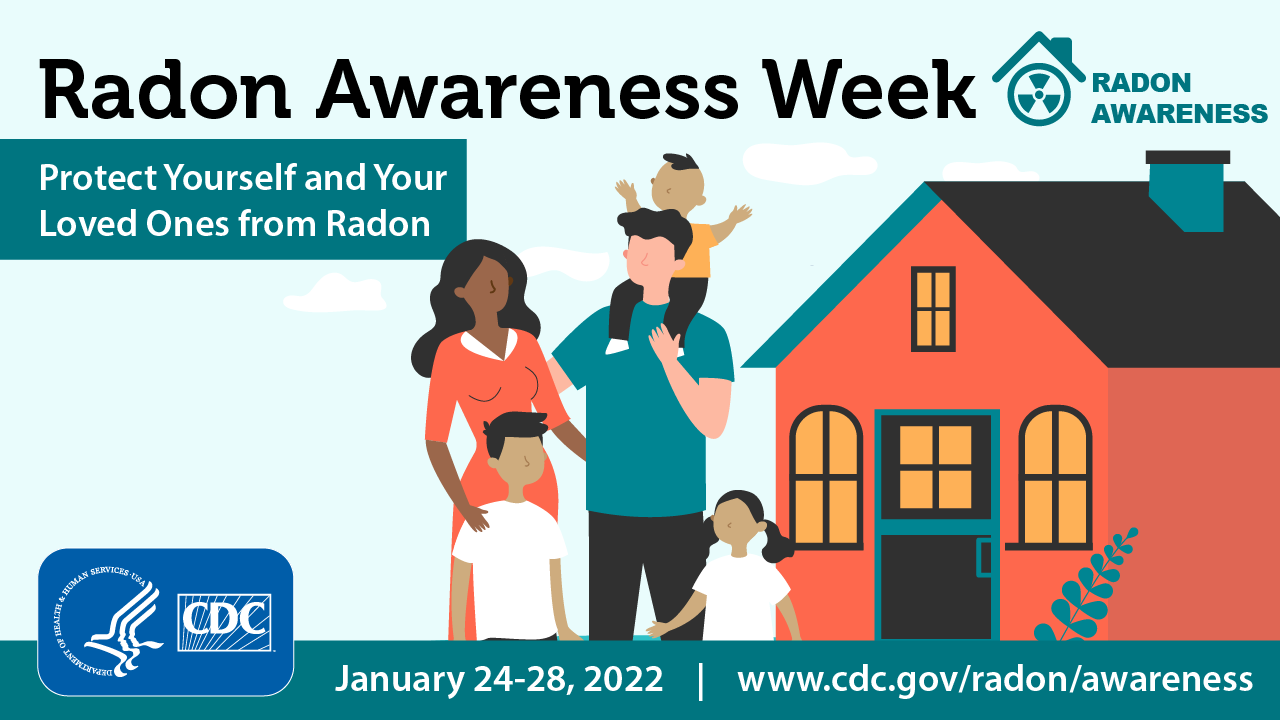
Radon causes about 21,000 lung cancer deaths in the United States every year and is the second leading cause of lung cancer, according to the Environmental Protection Agency. Radon is a naturally occurring radioactive gas that can get trapped in homes and buildings and expose the people who live and work inside, increasing their risk of developing lung cancer later in life. This risk is even higher among those who smoke cigarettes.
Radon Awareness Week, January 24–28
The good news is that exposures to high levels of radon are easily preventable. CDC’s 2022 Radon Awareness Week raises awareness about the combined risk of smoking and radon, shares information about state radon levels and resources, and informs and empowers homeowners, healthcare providers, and school building managers on steps they can take to reduce risks.
Visit CDC’s Radon Awareness Week page designed for partners and those who want to spread the word on social media with CDC’s daily theme graphics. CDC has also expanded its radon communication materials, updating the toolkit for state public health professionals, and adding new graphics, animations, and videos.
Updated Radon Website and Resources
CDC’s radon website has updated content, tools, and resources for individuals as well as agencies and organizations to use in their radon awareness efforts. Jackie’s Story, a new video, provides powerful, personal testimony about the importance of testing for radon and its role in lung cancer. Two new animated graphics show how radon gets into buildings and how only testing can tell you if you have a problem. The website also shares an important new resource for healthcare providers, who can encourage patients to learn about radon and whether they might be at risk for lung cancer if they are being exposed at home or in other settings.
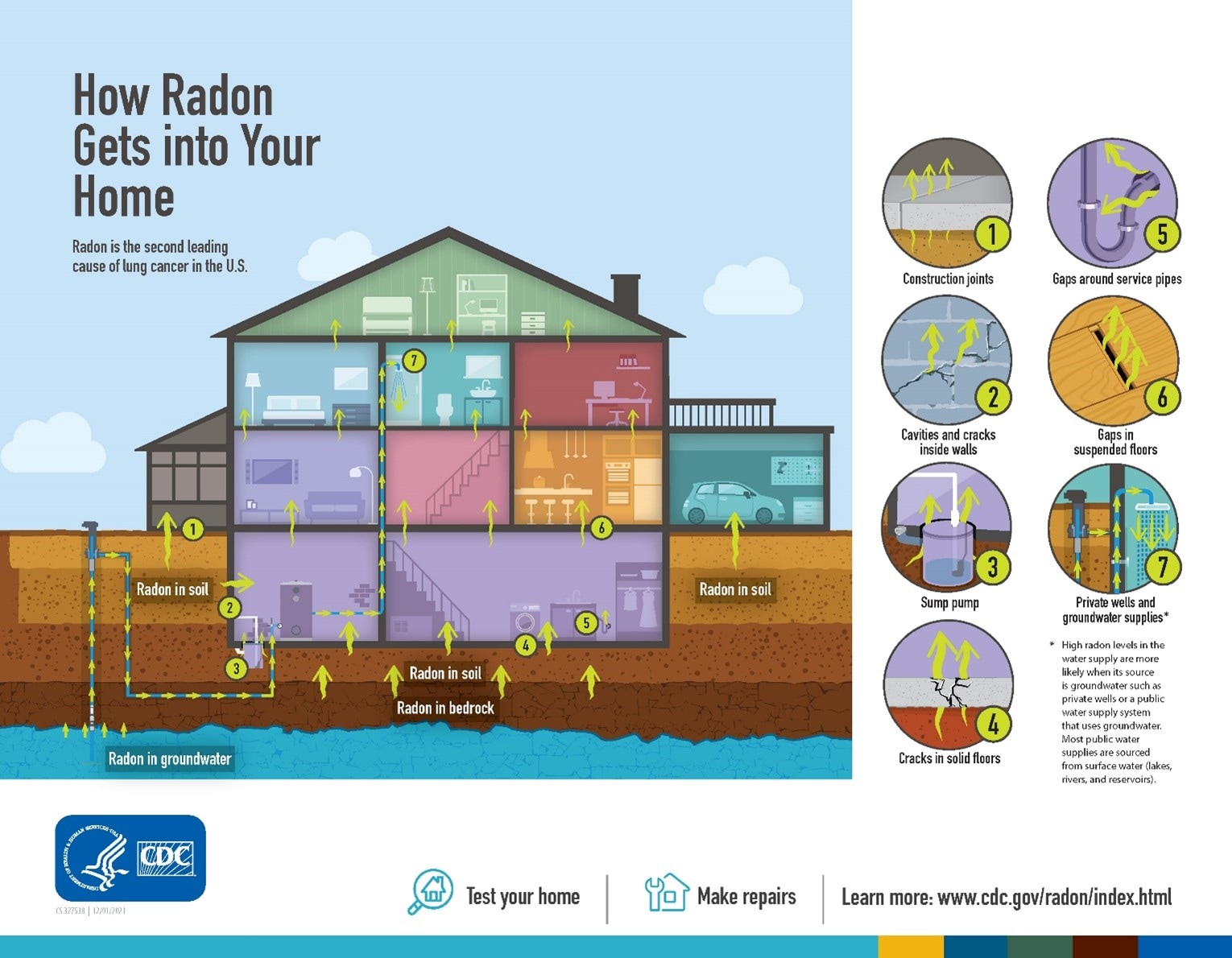
CDC’s 2022 Radon Awareness Week highlights these five daily themes:
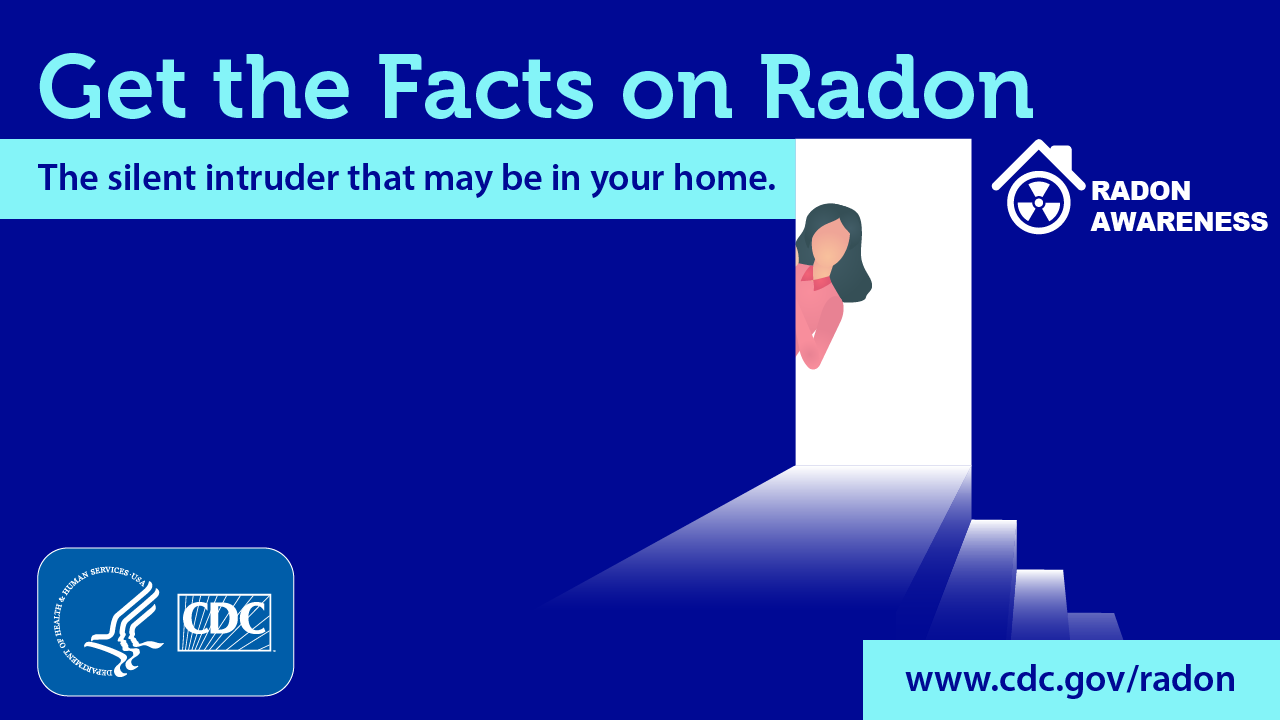
Monday:
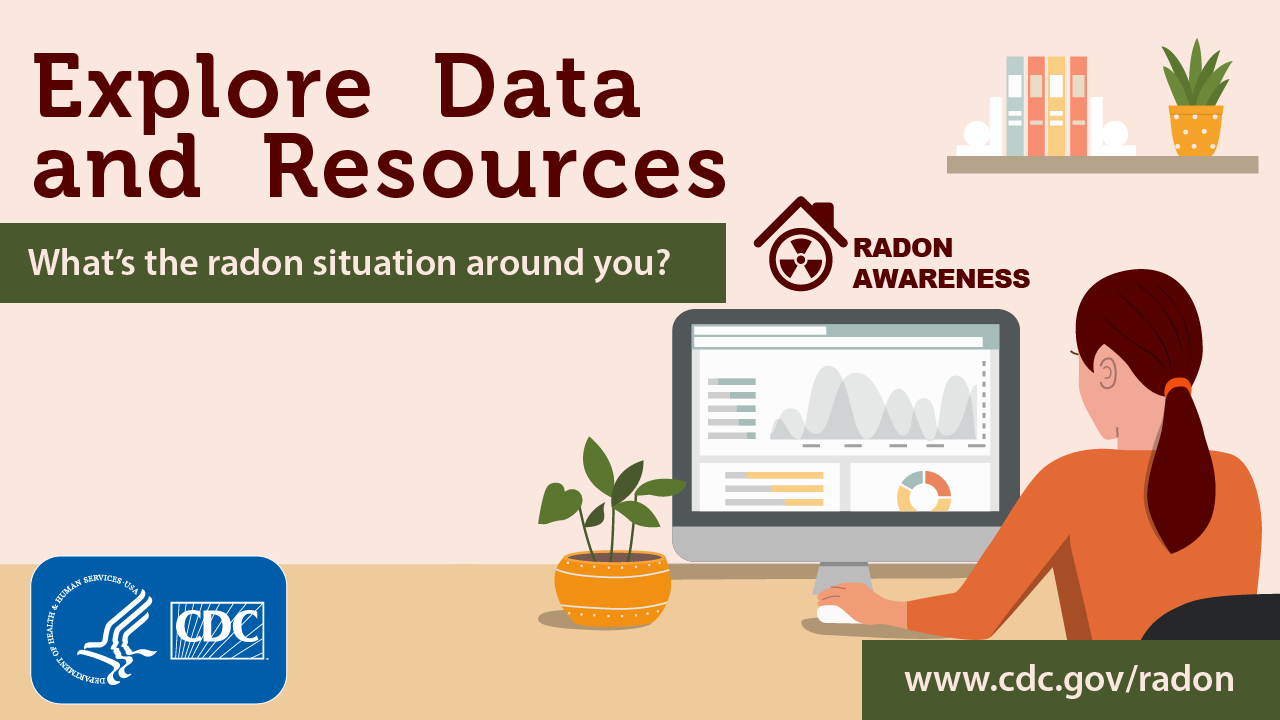
Wednesday:
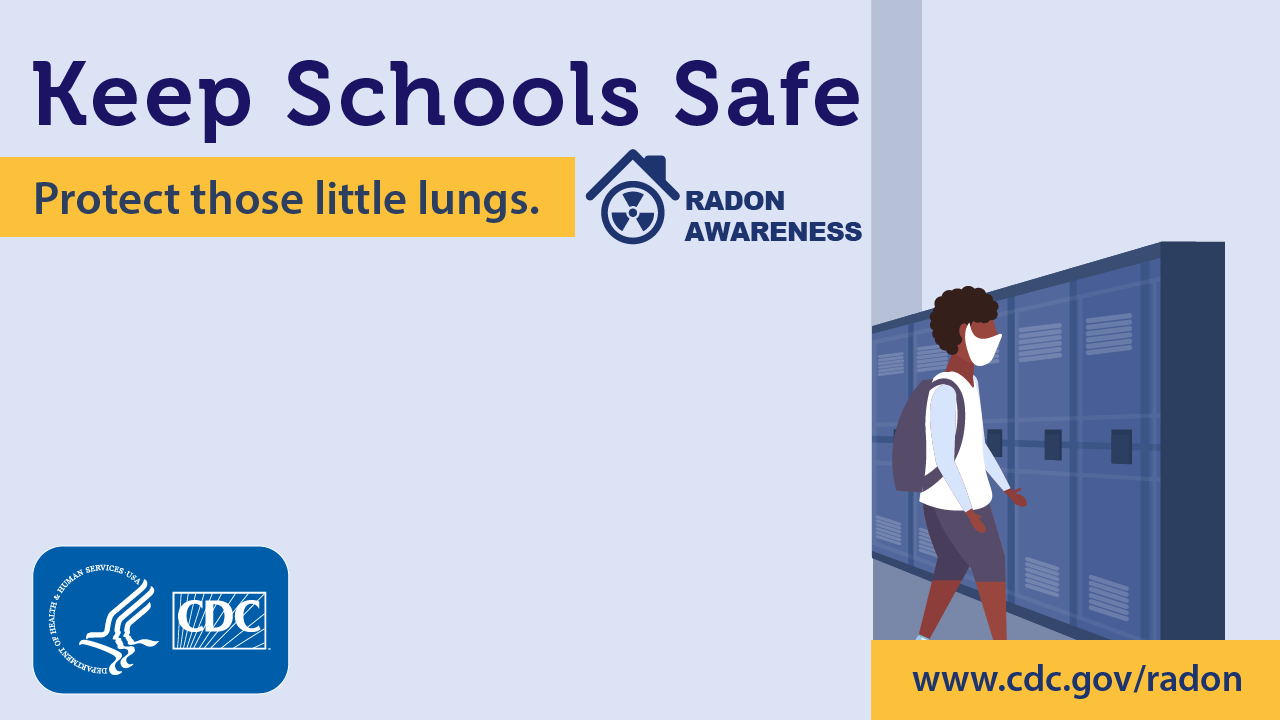
Thursday:
Please join us in Radon Awareness Week activities and learn more about this important public health topic! A CDC Environmental Health Nexus webinar will be held on January 24, 2022, to kick off the week. A separate invitation will come out the week before from the Radiation and Health Newsletter.
We encourage you to look for newsletters and social media postings each day during the week sharing the daily themes. Please invite other partners and colleagues to receive the newsletters and information about other resources and activities for Radon Awareness Week and other radiation-related topics, by subscribing here to the Radiation and Health Newsletter.
National Radon Action Plan
Radon is an important public health issue that also involves environmental health, housing, and health disparities, so working with federal partners is essential to addressing it. As part of a 12-member public-private partnership, CDC has been working with the Environmental Protection Agency, the Department of Housing and Urban Development, and partners representing health, radiation, energy, cancer, and building science experts to update the National Radon Action Plan [PDF – 1,012 KB] for 2021–2025. This plan builds on the earlier Federal Radon Action Plan, which focused on fixing buildings, radon-resistant construction practices, and building a radon professional workforce. The updated plan, which is expected to be finalized soon, adds emphasis on improving access to data to better assess progress and addressing social inequalities in radon knowledge and access to services.
A Fresh Look at Radiation and Medical Imaging
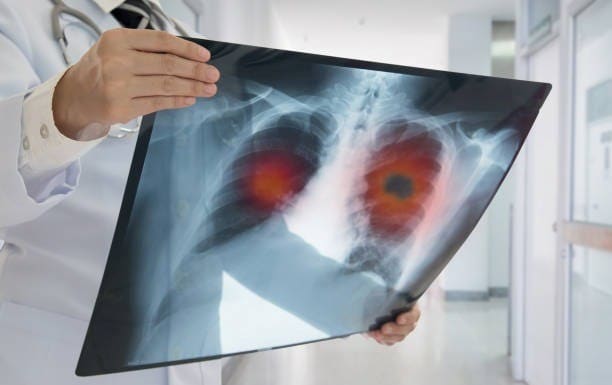
CDC has updated its website pages to provide more comprehensive, user-friendly content about the different medical procedures that use radiation for diagnostic imaging. Although high doses of ionizing radiation can be harmful to human health, radiation and radioactive materials are used every day in medical settings to improve health outcomes and even save lives.
Radiation is used in many medical imaging procedures. Medical radiation practices and equipment are regulated by state and federal programs to ensure safety.
There are possible long-term risks from the very low doses of radiation exposure from imaging procedures. Usually, the benefits of diagnosing or treating a health problem with an imaging procedure will outweigh these risks. These procedures only deliver radiation to the area that needs imaging, protecting all other parts of the body, and should always use the lowest amount of radiation needed to create a good quality image.
Learn more about these common imaging procedures on CDC’s website:
- Radiography (x-rays) and dental x-rays
- Mammography
- DEXA Scans (bone density)
- CT scans (computed tomography scans)
- Fluoroscopy
- Nuclear medicine
Be on the lookout in the Spring for the addition of webpages on the therapeutic use of radiation in health care.
Radiation Studies Chief, Robert C. (Bob) Whitcomb, Jr., Retires
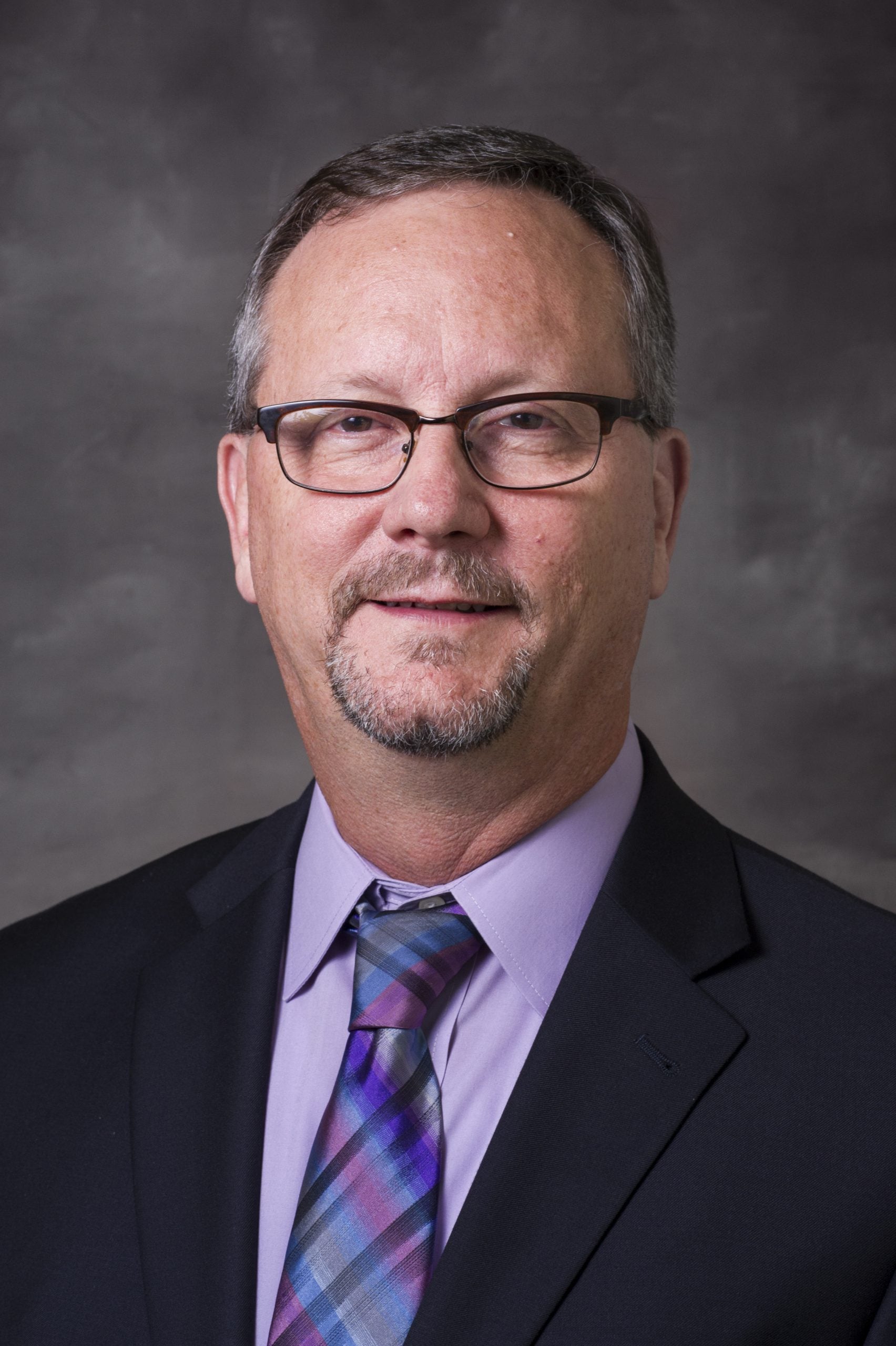
Dr. Robert C. Whitcomb, Jr., Chief of the Radiation Studies Section, National Center for Environmental Health, retired on December 31, 2021, with more than 28 years of service with CDC. As section chief, and formerly branch chief of Radiation Studies at CDC, Bob served as a leader and senior expert on radiation protection for public health. He is recognized as a national and international authority on radiological public health issues and risk assessment. Bob played an instrumental role in the nation’s radiation emergency preparedness efforts, helping to make the public health community aware of this significant preparedness need and leading efforts to build capacity at the local, state, tribal, territorial, and national levels.
Bob began his career at CDC in the Radiation Studies Branch in the Division of Environmental Hazards and Health Effects, NCEH, in 1993 as a physical scientist. He contributed scientific expertise to the agency’s efforts to assess radiation doses to numerous Cold War weapons production sites in the U.S., as well as population effects of nuclear testing in the Marshall Islands in the 1940s and 1950s. In 2011, Bob served as chief science advisor to the CDC director during the Fukushima Daiichi nuclear emergency (Japan), providing expertise and scientific direction to the agency’s public health response. He concurrently played a key role in the CDC Bridging the Gaps Conference that brought together more than 400 federal, state, and local officials to discuss radiation emergency preparedness—an unexpectedly timely meeting!
More recently, Bob provided co-leadership for the CDC Nuclear/Radiological Emergency Training and Exercise Program sponsored by the Center for Preparedness and Response. This program has made major strides in developing the Nuclear/Radiological Incident Annex to the CDC All Hazards Emergency Response Plan and developing a rad-savvy workforce that can activate quickly should a radiation emergency occur in our country. Bob also participated in national-level planning and exercising for a nuclear or radiological incident, participating with other federal agencies and White House personnel.
Bob’s plans include spending more time with family and enjoying outdoor sporting interests. He also hopes to continue his contributions to radiation protection science and practice, but at a more relaxed pace.
New Jersey Conducts Public Awareness Campaign for Radiation Emergencies
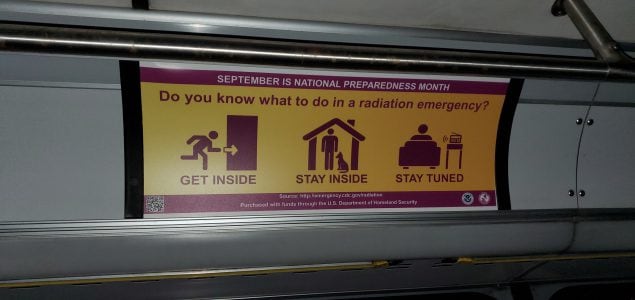
This past September, during National Preparedness Month, the New Jersey Department of Environmental Protection launched a public awareness campaign for radiation emergency preparedness. Jenny Goodman, manager of the Bureau of Environmental Radiation in the department, recently discussed the agency’s efforts to promote these critical protective action steps that people need to know in case of such an emergency.
CDC: What made you decide to do the campaign?
Ms. Goodman: The thought for this campaign started when I was shown the Ventura County (California) TV ads [PDF – 3.1 MB] on nuclear detonations and what the public should do. Years later my boss gave me a book on resiliency in communities following emergencies. And a while after that I attended a conference in New York City where Armin Ansari (of CDC’s Radiation Studies program) spoke about the Radiation Hazard Scale, a tool for explaining exposure risk in a radiation emergency. After the conference, I explored the CDC website and discovered the excellent graphics about what to do in a radiation emergency. I thought using the CDC graphics in ads would help make communities more aware of what to do to act resiliently during a radiological/nuclear incident.
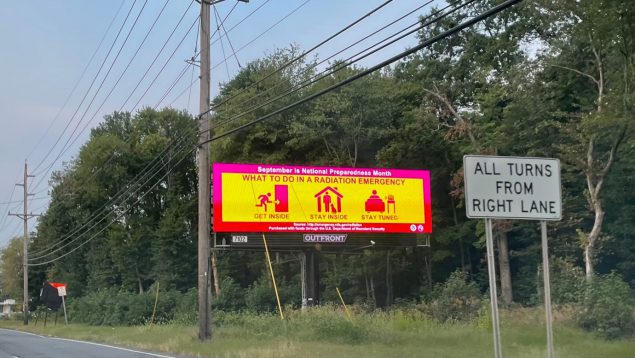
Based on federal modeling, 280,000 lives could be saved if members of the public at risk for fallout exposure quickly sheltered in a shallow basement or similar structure immediately following a 10-kt ground burst in a city the size of Los Angeles. I knew that educating the public on how to take appropriate actions in such an incident is critical to saving lives.
How did you get the funding for this effort?
First, we had to convince management of the necessity of this campaign. We found that it was important to put it in writing, and to show the impact this campaign would have—we emphasized that it would save lives and help state, local, tribal, and territorial partners. We reminded leadership that they are responsible for taking actions to save lives.
Once we had management support, we applied for a Department of Homeland Security grant through the New Jersey Office of Homeland Security and Preparedness (NJOHSP). Our application was rejected for 2019—we came a little late to the game, but we were not deterred and applied again for the 2020 grant. Besides, we thought, it is a good thing because COVID would be gone by September of 2020. We eventually were invited to pitch our idea to senior officials in NJOHSP. Our ad campaign was different from the usual awards that were made every year to police and other first responders, and we were awarded the grant.
CDC: What did you do to develop the campaign?
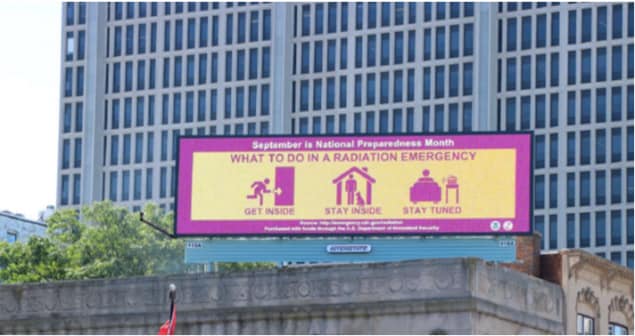
Ms. Goodman: We reached out to advertising vendors to obtain space for displaying graphics, and compiled the graphics, using CDC radiation emergency preparedness materials. We produced a number of digital ads that we had displayed on billboards and on NJ Transit trains, in train stations, and inside and outside New Jersey Transit buses; about one-fourth of the ads were in Spanish.
CDC: Was the campaign successful?
Ms. Goodman: Although many people were focused on the remnants of Hurricane Ida, which arrived in New Jersey at the same time as the campaign launched, we did see some uptake of the messages in social media, and on website hits on CDC’s pages, which CDC staff had noticed on their website monitoring. One of the most interesting things was that we anticipated the potential for public panic but didn’t see any. We provided a script for our Emergency Response Hotline to handle panicked phone calls about the campaign, but neither they nor our program received a single phone call. Some people expressed distrust on social media, with comments such as “What are you not sharing?” and “Should we be worried?” but there was no major alarm. In fact, the New Jersey Transit system had a clause in the agreement which allowed them to stop the campaign after 2 weeks if it caused any public outcry, but there was none, so the campaign lasted for the entire month. In fact, some of the bus and train ads remained in place past September!
CDC: What’s Next?
Ms. Goodman: Our grant lasts for 3 years, and although we are not limited to running the campaign in September, it helps since that is National Preparedness Month and provides a teachable moment that doesn’t cause as much concern. We are currently exploring digital ads in grocery stores, convenience stores, and on college campuses. We hope to try to partner with the Port Authority of New York and New Jersey on PATH commuter trains and Newark Liberty Airport next year to have a much broader reach.
CDC’s Public Health Emergency Preparedness Program (PHEP) Plans Webinar on New SimPLER Tool

In 2020, CDC released Community Reception Center (CRC) SimPLER, a planning tool for state and local public health emergency officials to estimate needed resources to set up CRCs after a radiation emergency. Since its successful launch, CDC personnel have been working to expand this useful tool for other public health emergencies involving points of distribution (PODs).
In the next Public Health Emergency Preparedness (PHEP) Connects webinar, CDC personnel will provide an overview of POD SimPLER and how it can used to help health departments estimate their throughput capacity for medication dispensing or vaccine administration in a way that is simple to understand, quick to interpret, and can be taken or presented to decision makers if/when they need to ask for additional resources. The webinar is scheduled for 1:00 p.m. EST on Wednesday, February 9, 2022. In the February webinar, “POD SimPLER: Point of Dispensing Simulation Program for Leveraging and Evaluating Resources – A Planning Tool for Public Health Emergencies,” Lauren Finklea, physical scientist with the National Center for Environmental Health, and Robert Garcia, lead health education specialist with the Division of State and Local Readiness in the Center for Preparedness and Response, will highlight new features of the SimPLER software and walk through example scenarios for use of the tool. POD SimPLER was developed through user testing with state, tribal, local, and territorial health departments around the country.
Participant Information
Dial-In: (669) 254-5252 (Audio only)
Meeting ID: 161 241 1865
Passcode: 569595
Web Link: https://www.zoomgov.com/j/1612411865
Please share this resource with your colleagues, partners, and networks.
Did you receive this newsletter from someone else?
Sign up for CDC’s Radiation and Health newsletter to get the latest updates, activities, and news about radiation and health and radiation emergency preparedness.
